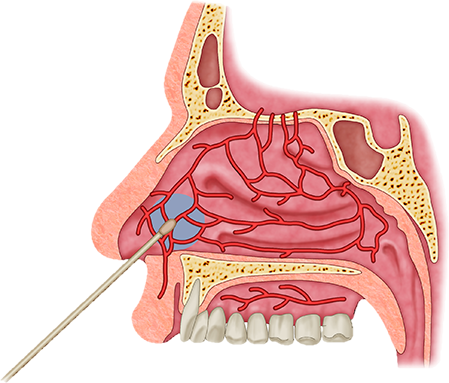
Nasal Cautery
Who is this information for:
This information is for patients, families and carers of patients who may need to undergo nasal cautery during their consultation with a MEG ENT surgeon.
What is Nasal Cautery:
Nasal Cautery is a minor procedure that your GP, ENT Surgeon or Emergency Department doctor may perform during your consultation, using good illumination with or without magnification, and some form of cautery device, usually a silver nitrate stick.
Applied to moist nasal cavity linings, the silver nitrate on the end of the stick release nitric acid, which causes a small, controlled chemical burn at the point where it is applied.
It is usually performed under local anaesthetic, one nostril at a time, but occasionally it is performed carefully in both nostrils at the same session.
Sometimes, a fine electric cautery device is used, though this is more common in the operating room under a general anaesthetic.
The procedure usually takes little more than 5 minutes.
Reasons You or your child might need Nasal Cautery
Nasal cautery is used to either stop an actively bleeding nose or to seal the culprit blood vessels in a nose prone to bleeding.
It is usually reserved for bleeding points / vessels towards the front of the nasal cavity which are readily accessible via the nostrils.
How is it performed?
Generally you are seated upright in a chair, but you may also be reclined, or lying down.
You ENT surgeon will first apply numbing solution, either as a spray, or on a small packing or cotton wool ball, to the nostrils.
This helps minimise any discomfort from the procedure, and can also help to initially slow any active bleeding.
After any packs have been removed, the nasal cavity is thoroughly inspected to identify prominent blood vessels or bleeding points.
The silver nitrate stick is then applied to these points with light pressure for a few seconds at a
time, to create a minor, precise burn, sealing the blood vessels.
If both sides of the nose are treated, your surgeon will be careful to minimise the amount of burning performed, and will try to avoid burning directly opposing areas of each nostril, so as to avoid complications (see below).

After this is complete, your surgeon may apply a small amount of moisturising or antibiotic ointment, or a small dissolvable dressing into the nostril against the treated areas.
If there is any initial vigourous bleeding, you surgeon may need to use a small suction device to help clear away the blood.
In the rare event that bleeding becomes hard to control with cautery alone, your surgeon may need to place a small pack, back into the nose for a period of time (2-48 hours).
What will I experience:
Nasal cautery is generally very well tolerated, and is often performed successfully in young children as well as adults.
The most common aspect of this part of the procedure is some brief stinging discomfort when the Silver nitrate stick is applied to the nasal lining, even with good local anaesthetic numbing.
Discomfort may actually ‘recur’ 30 mins to an hour after the procedure, as the numbing solution begins to wear off. This mild throbbing / aching sensation settles down over the next few hours, but may need some simple pain relief such as paracetamol or ibuprofen.
Afterwards, your surgeon will give you simple first aid advice, and encourage you to minimise nasal trauma such as nose blowing and excessive wiping for a week or so.
What are the risks:
Precisely performed, the risks of nasal cautery are minor.
The most common risk is that the silver in the cauterised area drips out onto the skin of the upper lip and face, and can non-permanently discolour the skin, usually a dark brown. If this happens it disappears after a few days to weeks.
The minor discomfort may cause some patients to briefly feel light-headed, or rarely, faint – though this is very uncommon.
An uncommon, but important complication is a septal perforation. There is a small chance that an area of cautery can become infected, and/or fail to heal, possibly leading to a small hole in the septum (the party-wall dividing the nostrils). If this does happen, it often doesn’t cause any symptoms, but may cause further nose bleeds, feeling of nasal blockage and crusting, and occasionally a whistling noise when breathing through the nose. It can be repaired where required, with an operation.
Lastly, nasal cautery may need to be repeated, either on the same side, or on the opposite side, once the first area of treatment has healed.
What are the benefits:
Generally the procedure is brief and very effective in arresting minor nose bleeds, and preventing recurrence.
It is performed under local anaesthetic and so recovery is quick.
It can be repeated as required, as long as there is adequate healing.
Are the any alternatives:
There are a number of topical creams and ointments that your surgeon may use prior to considering nasal cautery – these are usually combinations of moisturisers, antiseptics or antibiotics, and sometimes blood vessel constrictors. Some examples include Vaseline®, Chlorsig®, Nasalate®, Bactroban® Nasal Ointment, FESS® nasal gel, paw paw cream.

Sometimes, small dissolvable dressings are used where cautery is less likely to be successful or tolerated – For example, in patients on blood-thinning agents, or where the bleeding is from a more diffuse, raw area of the nasal lining.
Some patients would prefer to have the procedure under a general anaesthetic, and in these cases, electro-cautery is more likely to be used.
Further Information
You can contact your ENT Specialist at the Melbourne ENT Group (MEG):
- Phone: 1300- 952-808
- Email: admin@melbentgroup.com.au
- Website: www.melbentgroup.com.au
Your GP is also the best contact for ongoing care and concerns.